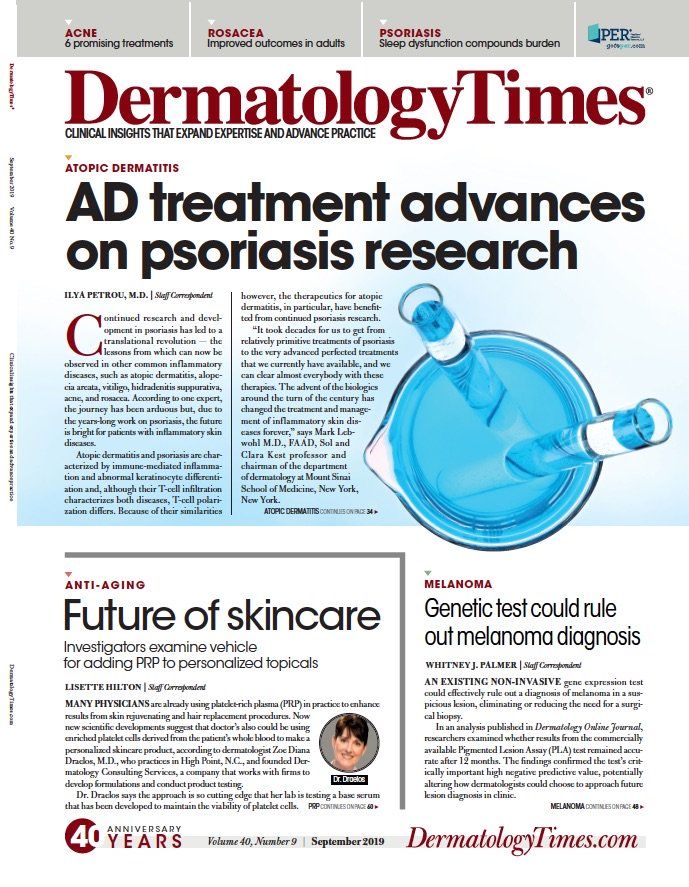- Case-Based Roundtable
- General Dermatology
- Eczema
- Chronic Hand Eczema
- Alopecia
- Aesthetics
- Vitiligo
- COVID-19
- Actinic Keratosis
- Precision Medicine and Biologics
- Rare Disease
- Wound Care
- Rosacea
- Psoriasis
- Psoriatic Arthritis
- Atopic Dermatitis
- Melasma
- NP and PA
- Skin Cancer
- Hidradenitis Suppurativa
- Drug Watch
- Pigmentary Disorders
- Acne
- Pediatric Dermatology
- Practice Management
- Prurigo Nodularis
- Buy-and-Bill
Publication
Article
Dermatology Times
Genetic test could rule out melanoma diagnosis
Author(s):
In a recent analysis, researchers examined whether results from a lesion diagnostic assay remained accurate after 12 months. The findings could alter how dermatologists approach future melanoma diagnosis in clinic.
An existing non-invasive gene expression test could effectively rule out a diagnosis of melanoma in a suspicious lesion, eliminating or reducing the need for a surgical biopsy.
In an analysis published in Dermatology Online Journal, researchers examined whether results from the commercially available Pigmented Lesion Assay (PLA) test remained accurate after 12 months. The findings confirmed the test’s critically important high negative predictive value, potentially altering how dermatologists could choose to approach future lesion diagnosis in clinic.
RELATED: Genetic insights improve tumor classification
And, based on the outcomes, says study author Daniel Siegel, M.D., a dermatology professor at SUNY Downstate Medical Center, the test could benefit patients, as well as providers.
“For melanoma, there is no other purely diagnostic assay for doctors to use,” he says. “We have good prognostic assays, but this is the only diagnostic test that is both sensitive and specific, that isn’t disruptive or harmful to the patient.”
To determine PLA’s long-term validity, Dr. Siegel and his team followed up on previous research that determined whether 1,575 lesions contained genes associated with melanoma, particularly Preferentially Expressed Antigen in Melanoma (PRAME) and Long Intergenic Non-Coding RNA 518 (LINC00518). In the current analysis, they re-examined the 734 previously PLA-evaluated lesions that tested negative for any melanoma gene expression.
Follow-ups to identify any status changes occurred at three-month, six-month, and 12-month intervals. Throughout the year, only 13 lesions (1.8 percent) were referred for surgical biopsy. Six were biopsied at patient request, and seven were biopsied to provide information on changing lesions. None tested positive for melanoma.
These results on test performance are clinically important, he says, because they underscore the accuracy of a non-invasive diagnostic method that is far easier to administer than a surgical biopsy. Dermatologists or primary care providers could use the PLA test to gather cells in under two minutes by pressing adhesive patches over the suspicious lesion four times. Those patches are, then, packaged and sent off for analysis. Results are available within 72 hours.
Overall, the test prevents fewer opportunities for a missed or incorrect diagnosis, he says.
RELATED: Adjunct molecular tests aid melanoma diangosis
“Melanoma, under the microscope, can range from being obvious enough for a first-year medical student with minimal training to recognize it to being something a 25-year veteran dermatopathologist will scratch his or her head trying to figure out,” Dr. Siegel says. “But, with the PLA test, if a patient doesn’t have the genes, there’s a good chance he or she doesn’t have melanoma.”
The adhesive patch test is potentially a superior diagnostic method, he says, because traditional lesion biopsies examine only a small portion of a single slice of the suspicious area, much like examining one corner of a single slice removed from a larger loaf of bread. Instead of getting a random view, PLA pulls cells from across the top of a lesion, in essence giving providers a detailed look at the entire spot.
By providing a more detailed test sample, PLA can significantly reduce the number of lesions sent away for biopsy, Dr. Siegel says. In fact, according to the study, PLA decreases the number of lesions that must be biopsied to detect a melanoma from 25 to 2.7. And, helping dermatologists and primary care providers control the biopsy rate is vitally important in a healthcare environment that scrutinizes utilization and levies penalties on outliers.
PLA could also offer economic benefits, he says. Largely driven by the reduced number of biopsies, the test might also save money by helping patients side-step the costs associated with stage-related treatments that accompany overlooked melanomas. The test’s $500 price tag could nearly halve expenditures, as well, as a 47% reduction over the cost of a surgical biopsy.
Alongside facilitating drops in cost and use, PLA could also improve the speed of patient care, particularly if a questionable lesion is first noticed or addressed by a primary care provider rather than a dermatologist.
“While dermatologists do a pretty good job of determining which lesions are suspicious, family doctors can frequently encounter situations where they’re not sure,” Dr. Siegel says. “They’ll tell a patient to watch-and-wait. And, suddenly seven months later, the patient has returned, and he or she has metastasis.”
A faster answer of whether melanoma is present could prompt the doctor to initiate treatment sooner rather than later.
Ultimately, Dr. Siegel says, these study results support using the PLA test as a method to quickly and non-invasively determine whether a suspicious lesion requires additional intervention. It’s also a strategy that could minimize discomfort and fear for the patient while avoiding any unnecessary permanent scarring.
“If you don’t have to cut, you don’t leave a mark or a scar,” he says. “If there’s something concerning in a cosmetically sensitive area, and you can simply take a strip of cells from the surface to conduct an assay, then you can potentially reassure the patient that a lesion might be benign without leaving him or her with a mark to be remembered for the rest of their lives.”ï






